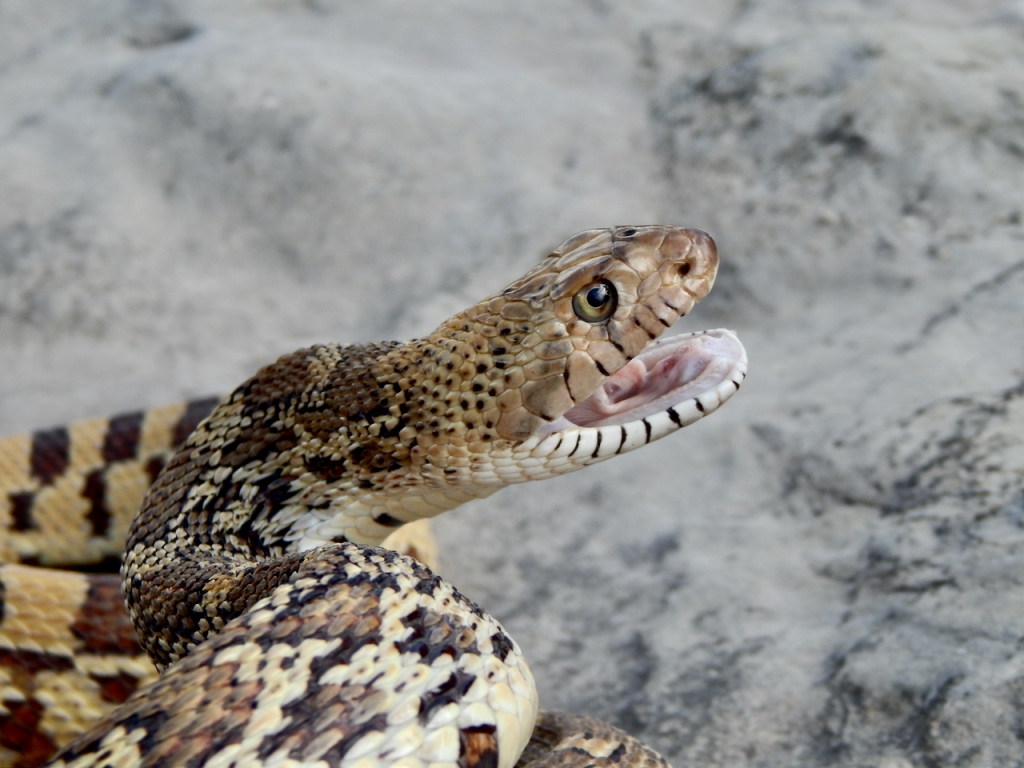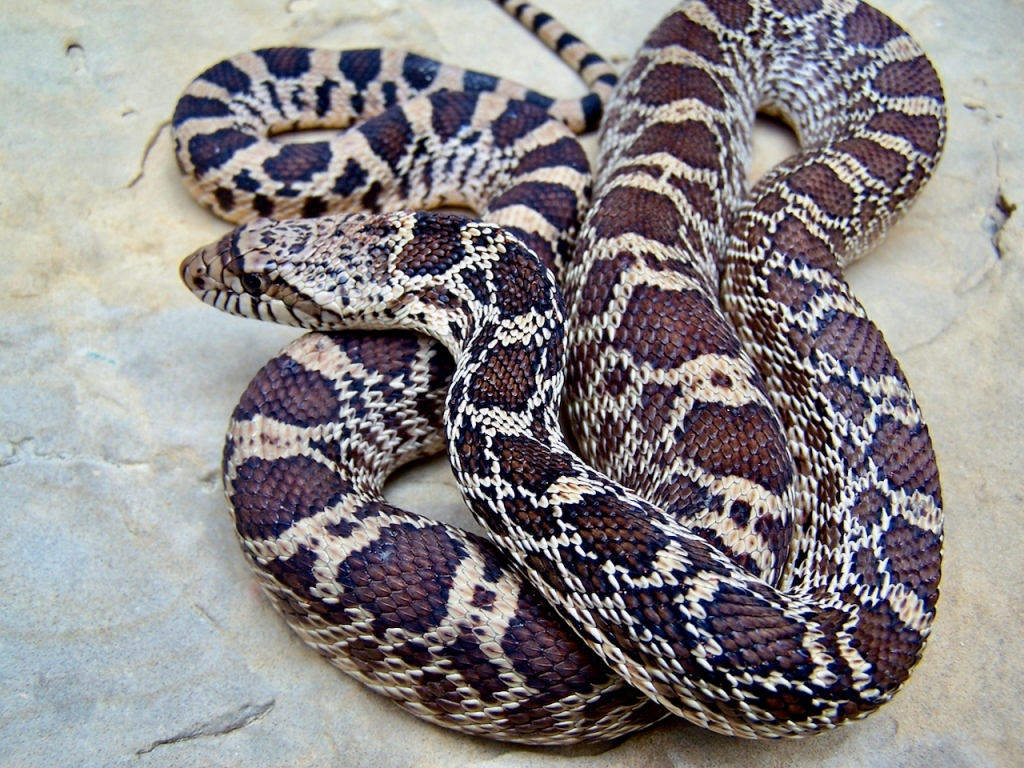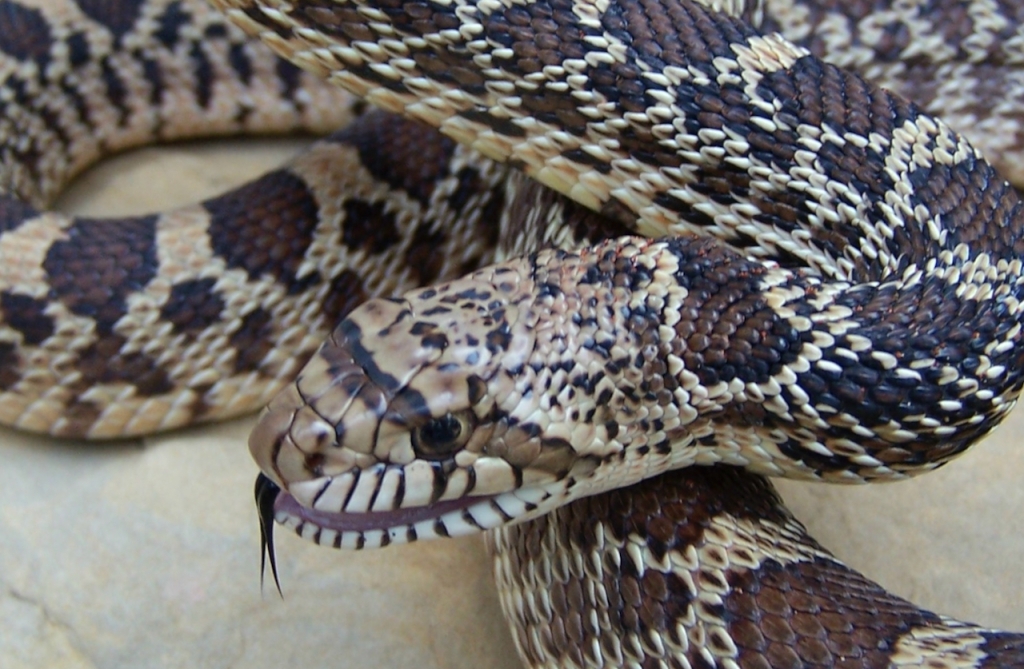Sometimes, however, it is not so gentle:
“A sudden encounter with a large, angry bull snake in the wild can be an awesome, even frightening experience for the uninitiated. Almost everything about the reptile’s defensive behavior looks or sounds menacing.”
– John Werler and James Dixon, Texas Snakes

The bullsnake is a large snake, growing to lengths greater than five feet and occasionally approaching nine feet, according to Werler & Dixon. When threatened, this large snake generally pulls itself into a coil, vibrates its tail, and with head and neck held high and ready to strike, it hisses loudly. The snake’s mouth is open at least partly. A vertical flap of cartilage at the opening of the windpipe amplifies that hiss so that it is loud and has a little rattling quality, suggesting the high buzz of a defensive rattlesnake.
If the source of threat is very close, the bullsnake will then strike at the offending animal or human with a dramatic hiss. Occasionally it is just a bluff; Clint King and I picked one up off a road one time to keep it from being hit by a car, and it hissed but never tried to bite. More often, bullsnakes are willing to bite. Their rows of sharp teeth leave nothing more than scratches, as the teeth are small and the snake has no venom.
A few bullsnakes have more timid or calm temperaments, especially those bred in captivity. Knowing how intimidating they can be when frightened, a calm bullsnake can seem like a gentle giant as its big, powerful body moves across your arms or shoulders. A snake like that is my favorite choice for educational presentations, hopefully adding to participants’ appreciation for native species.

A bullsnake’s neck has dark brown rounded or irregular blotches which gradually become spaced further apart. There are dark blotches and spots on the side of the body as well, on a sandy or yellowish-brown ground color. Near the tail, the dorsal blotches become darker and the tail is nearly ringed by these dark blotches on a yellowish-tan ground color. The head is a light caramel or yellowish color with some dark freckles, and a darker brown band crosses the snout just in front of the eyes and runs diagonally through each eye and back toward the jaw line. Where most of our nonvenomous snakes have two prefrontal scales on the top of the head just in front of the eyes, the bullsnake (and the pine and gopher snakes) have four.

Let’s talk just for a moment about that name for the genus – Pituophis. Where does that name come from? A book from 1974, Snakes of the American West, claimed that this name translated to “phlegm serpent,” but this appears to be an error. I’ve seen a similar claim made in a self-published book on Amazon. I went looking for the real etymology of the word.
The second part of the genus (“-ophis”) means snake, but the first part derives from a Greek word for pine (“pitys”). An earlier synonym for the genus was spelled “Pityophis,” but you have to look through the research literature from many years ago to see that spelling. No matter how much the hiss sounds wet and rattling, it is not a “phlegm serpent.”
Where are they found?
The bullsnake is one of several species of Pituophis in the U.S. that range from coast to coast and from Canada to Mexico. In the eastern U.S., they are called pine snakes, and in the western U.S. they are gopher snakes. In the middle, reaching from northern Mexico up through central and west Texas, stretching out in the Plains states and up to southern Canada, is the bullsnake.
In Texas, the bullsnake is found west of a line that runs approximately through the DFW metroplex down through San Antonio to around Victoria, according to Dixon. Around the Pecos River, it transitions into another subspecies, the Sonoran gophersnake.

Natural history accounts of the bullsnake usually mention their preference for prairies and grasslands. A study from southwestern Wisconsin showed that they preferred bluffs with open spaces between trees and did not use closed canopy forest or agricultural lands (Kapfer and others, 2008). Werler & Dixon mention the bullsnake’s fondness for agricultural fields containing rodent prey. I don’t know how to reconcile the statements about agricultural lands.
What do they eat?
Most of the bullsnake’s diet is made up of small mammals such as mice, rats, gophers, and ground squirrels. They spend considerable time exploring burrows and tunnels to find their prey, according to Werler & Dixon. The snake is very well adapted for such behavior. The bones in the snout are more rigid than those of most snakes so that in sandy soil it can use its head to dig. The bullsnake’s skills as an excavator were described by Carpenter, who tested eight bullsnakes in an enclosure with sand substrate. The snakes generally began prodding the sand next to a stable object and began digging sand with sideways movements of the head. Then, the snake bent its head to the side to scoop loosened sand and move it away. A loop of the neck continued to push the sand backward. In further testing, bullsnakes were seen to excavate tunnels up to a meter long. Additionally, Carpenter examined whether bullsnakes would recognize pocket gopher mounds, and showed that these snakes actively explore and excavate pocket gopher burrows in attempt to eat the gophers.
Once they locate a gopher or other prey animal, the bullsnake grabs and constricts it with powerful coils. What about rodents discovered in burrows? There may not be space to wrap around the rodent, and so the bullsnake uses a portion of its body to press the animal against the side of the burrow, ultimately having similar effect to constriction.
Bullsnakes are also reported to be fond of eating eggs, raiding the nests of ducks and other birds.
How do they reproduce?
Bullsnakes mate “soon after they leave hibernation,” according to Werler & Dixon, in “late April or May” (page 235). A study by Iverson and others in the sandhills of Nebraska found courtship and mating to occur in May and egg-laying to occur in June or July. Bullsnakes lay very big eggs in protected, moist locations and they hatch around two months later. The babies are a little over a foot long.
As our climate changes, winter dormancy may end earlier. Could this result in a shift in reproductive timing? And will hatchlings emerge into a hotter, drier environment here in Texas and find it difficult to thrive? I suppose we do not know.
What conservation challenges do they face?
In the Iverson study in Nebraska mentioned above, the authors stated, “At the most intensive site of removal, where every bullsnake observed along a 1,100-m drift fence was removed or relocated for 8 consecutive years (Gimlet Lake), number of snakes captured during the same period each year did not decrease” (p. 59). That may be encouraging news about the potential for these snakes to withstand collection. It is not clear whether they can withstand other threats like habitat loss.
NatureServe shows the bullsnake as a species of “special concern” in Canada because of habitat loss and road mortality, while it is “secure” in the U.S. The International Union for Conservation of Nature (IUCN) considers bullsnakes and gophersnakes (Pituophis catenifer) a species of “least concern.”
Carpenter, C.C. 1982. The bullsnake as an excavator. Journal of Herpetology, 16(4), Pp. 394-401.
Dixon, J.R. 2013. Amphibians and Reptiles of Texas, 3rd Edition. College Station: Texas A&M University Press.
Iverson, J.B., Young, C.A., Akre, T.S.B., & C.M. Griffiths. 2012. Reproduction by Female Bullsnakes (Pituophis catenifer sayi) in the Nebraska Sandhills. Southwestern Naturalist, 57(1), 58-73.
Kapfer, J.M., J.R. Coggins and R. Hay. 2008. Spatial ecology and habitat selection of bullsnakes (Pituophis catenifer sayi) at the northern periphery of their geographic range. Copeia 2008(4), Pp. 815-826.
Shaw, C.E. & S. Campbell. 1974. Snakes of the American West. NY: Knopf.
Werler, J.E. & J.R. Dixon. 2000. Texas Snakes: Identification, Distribution, and Natural History. Austin: University of Texas Press.